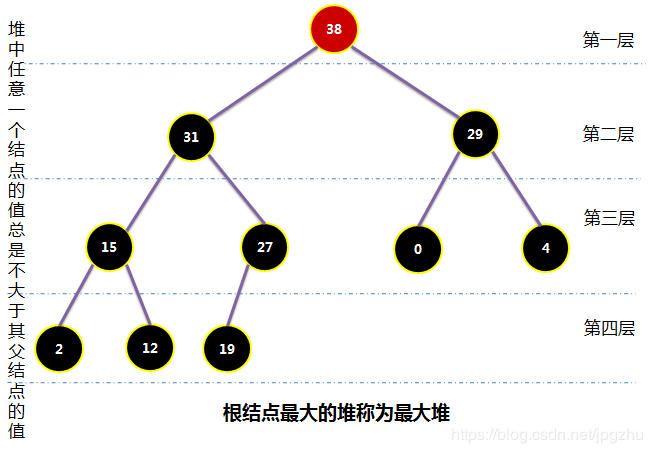目錄
- 背景
- 概念
- 最大堆
- 最大堆的線性存儲
- 動畫實現最大堆加入新元素
- 代碼實現最大堆加入新元素
- 動畫實現最大堆取出最大元素
- 代碼實現最大堆取出最大元素
- 程序測試
- 最大堆的應用–優先隊列
- 寫在最後
背景
- 二叉樹是數據結構中的重點,也是難點。二叉樹比數組、棧、隊列等線性結構相比複雜度更高,想要做到心中有“樹”,需要自己動手畫圖、觀察、思考,才能領會其真諦。
- 在上篇文章《自己動手作圖深入理解二叉樹、滿二叉樹及完全二叉樹》中,我們對完全二叉樹有了一定認識,該文將對一種特殊的完全二叉樹”最大堆”進行底層研究。
概念
堆(heap)通常是一個可以被看做一棵二叉樹的數組對象。堆總是滿足下列性質:
- 堆總是一棵完全二叉樹。
- 堆中某個節點的值總是不大於或不小於其父節點的值;
最大堆
- 根節點最大的堆叫做最大堆
最大堆的線性存儲
- 由於堆是一種特殊的完全二叉樹,可以利用數組集合形成線性存儲的數據結構。
/**
* 最大堆的底層實現--數組集合形成線性存儲的數據結構
* * @author zhuhuix
* @date 2020-06-28
*/
public class MaxHeap<E extends Comparable<E>> {
// 存放元素的數組集合
private ArrayList<E> list;
MaxHeap() {
this.list = new ArrayList<>();
}
// 得到左孩子索引
private int getLeftChildIndex(int i) {
return (2 * i + 1);
}
// 得到右孩子索引
private int getRightChildIndex(int i) {
return (2 * i + 2);
}
// 得到父結點索引
private int getParentIndex(int i) {
if (i == 0) {
throw new IllegalArgumentException("非法索引值");
} else {
return ((i - 1) / 2);
}
}
}
動畫實現最大堆加入新元素
- 加入到數組集合尾部的元素與父結點進行比較,通過上浮操作,保證所有子結點不能大於父結點。
代碼實現最大堆加入新元素
/**
* 最大堆的底層實現
*
* @author zhuhuix
* @date 2020-06-28
*/
public class MaxHeap<E extends Comparable<E>> {
// 存放元素的數組集合
private ArrayList<E> list;
MaxHeap() {
this.list = new ArrayList<>();
}
// 得到左孩子索引
private int getLeftChildIndex(int i) {
return (2 * i + 1);
}
// 得到右孩子索引
private int getRightChildIndex(int i) {
return (2 * i + 2);
}
// 得到父結點索引
private int getParentIndex(int i) {
if (i == 0) {
throw new IllegalArgumentException("非法索引值");
} else {
return ((i - 1) / 2);
}
}
// 添加元素
public void add(E e) {
this.list.add(e);
/**
* 將加入的結點與父結點進行比較:
* 如果加入的結點大於父結點,則進行上浮
* 直至新結點小於或等於父結點為止
*/
// 獲取當前添加元素在數組中的索引
int i = this.list.size() - 1;
while (i > 0) {
E current = this.list.get(i);
E parent = this.list.get(getParentIndex(i));
// 如果父結點元素大於當前加入的元素,則進行交換
if (parent.compareTo(current) < 0) {
// 交換新加入的結點與父結點的位置
Collections.swap(this.list, i, getParentIndex(i));
} else {
break;
}
i = getParentIndex(i);
}
}
}
動畫實現最大堆取出最大元素
- 獲取最大堆中的根結點,即為最大元素;並把尾部結點放置到根結點,並通過下沉操作,把子結點中的最大元素移動根結點。
代碼實現最大堆取出最大元素
/**
* 最大堆的底層實現
*
* @author zhuhuix
* @date 2020-06-28
*/
public class MaxHeap<E extends Comparable<E>> {
// 存放元素的數組集合
private ArrayList<E> list;
MaxHeap() {
this.list = new ArrayList<>();
}
// 得到左孩子索引
private int getLeftChildIndex(int i) {
return (2 * i + 1);
}
// 得到右孩子索引
private int getRightChildIndex(int i) {
return (2 * i + 2);
}
// 得到父結點索引
private int getParentIndex(int i) {
if (i == 0) {
throw new IllegalArgumentException("非法索引值");
} else {
return ((i - 1) / 2);
}
}
// 查找最大元素
public E findMax() {
if (this.list.size() == 0) {
return null;
}
// 最大堆中的元素永遠在根結點
return this.list.get(0);
}
// 取出最大元素
public E getMax() {
if (findMax() != null) {
E e = findMax();
/**
* 取出最大元素后,需要把堆中第二大的元素放置在根結點:
* 將根結點元素與最後面的元素進行交換,
* 讓最後面的元素出現在根結點,並移除最大元素
* 將根結點的元素與左右孩子結點比較,直至根結點的元素變成最大值
*/
int i = 0;
Collections.swap(this.list, i, this.list.size() - 1);
this.list.remove(this.list.size() - 1);
// 通過循環進行當前結點與左右孩子結點的大小比較
while (getLeftChildIndex(i) < this.list.size() && getRightChildIndex(i) < this.list.size()) {
int leftIndex = getLeftChildIndex(i);
int rightIndex = getRightChildIndex(i);
// 通過比較左右孩子的元素哪個較大,確定當前結點與哪個孩子進行交換
int index = this.list.get(leftIndex).compareTo(this.list.get(rightIndex)) > 0 ? leftIndex : rightIndex;
if (this.list.get(i).compareTo(this.list.get(index)) < 0) {
Collections.swap(this.list, i, index);
} else {
// 如果當前結點都大於左右孩子,則結束比較
break;
}
i = index;
}
return e;
} else {
return null;
}
}
}
程序測試
/**
* 最大堆的底層實現--測試程序
*
* @author zhuhuix
* @date 2020-06-28
*/
public class MaxHeapTest {
public static void main(String[] args) {
MaxHeap<Integer> maxHeap = new MaxHeap<>();
// 將10個数字加入形成最大堆
int[] arrays = {19,29,4,2,27,0,38,15,12,31};
for (int i = 0; i < arrays.length; i++) {
maxHeap.add(arrays[i]);
}
// 依次從堆中取出最大值
for (int i = 0; i < arrays.length; i++) {
System.out.println("第"+(i+1)+"次取出堆目前的最大值:"+maxHeap.getMax());
}
}
}
最大堆的應用–優先隊列
優先隊列:出隊的和順序與入隊的順序無關,只與優先級相關;
優先隊列通常可以採用最大堆的數據結構來實現。
/**
* 用最大堆的數據結構實現優先隊列
*
* @author zhuhuix
* @date 2020-06-28
*/
public class PriorityQueue<E extends Comparable<E>> {
private MaxHeap<E> mhp;
PriorityQueue() {
mhp=new MaxHeap<>();
}
// 入隊
public void enqueue(E e) {
mhp.add(e);
}
// 優選級最高的元素出隊
public E dequeue() {
return mhp.getMax();
}
// 查看優先級最高的元素
public E getFront() {
return mhp.findMax();
}
}
寫在最後
- 以上通過畫圖、動畫演示、代碼編寫對堆與最大堆的概念和底層實現方式,都作了深入分析;作為最大堆的反向結構,最小堆的實現也是一樣,讀者可參考以上動畫和代碼,動手練習。
- 畫圖、編碼不易,請點贊、收藏、關注三連!!!
本站聲明:網站內容來源於博客園,如有侵權,請聯繫我們,我們將及時處理
【其他文章推薦】
※網頁設計一頭霧水該從何著手呢? 台北網頁設計公司幫您輕鬆架站!
※網頁設計公司推薦不同的風格,搶佔消費者視覺第一線
※想知道購買電動車哪裡補助最多?台中電動車補助資訊懶人包彙整
※南投搬家費用,距離,噸數怎麼算?達人教你簡易估價知識!
※教你寫出一流的銷售文案?
※超省錢租車方案
